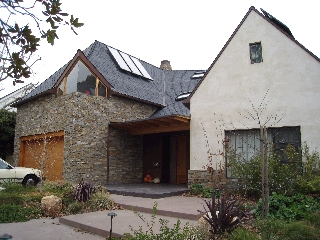 I’m thinking about reporting on this house as an example of sensible environmental design reproducible for the masses. Can anyone help me decide? This is a press release (emphasis mine):
I’m thinking about reporting on this house as an example of sensible environmental design reproducible for the masses. Can anyone help me decide? This is a press release (emphasis mine):
We handle parenting author, environmentalist, and “The Crafty Mom” Mary Lyon who recently built her 6,700 square foot spectacular “green” home in Brentwood, California. Below is some info on this amazing house, which Mary describes as “The Jetsons meets the Flintstones.” …
Parenting author, environmentalist, and “The Crafty Mom,” Mary Lyon recently built her “green” house. The 6,700 square foot three-story passive solar home (including a basement) is equipped with solar photovoltaic panels that generate electricity (9 kilowatts will be generated to run the house), eliminating the need for a generator and offering energy security, and solar heated hot water, which is integrated with an in-floor radiant heating system. One hundred percent of the roof tiles and resilient flooring are made out of recycled tires. The self-sustaining home is “designed to last 200 years,” says Lyon. The environmentally conscious Lyon wanted to have a house “tailored to the family and who we are. The house doesn’t force us to give up anything — it is up to us to fulfill its purpose.”
Insulation (Ultratouch) for the home is made from post-industrial blue jean manufacturing, and woods are composite wood products — palm wood for flooring and bamboo for the ceilings. Bamboo is a fast-growing renewable resource and palm wood is taken from crops of already chopped down palm trees (otherwise, trees are cut and the wood is left to rot on beaches.)
A trapezoid-shaped water wall artwork by artist Blue McRight measuring close to 18 feet high greets those entering the home for a feeling of immediate tranquility. An automated lighting system with motion and pressure sensors is set up throughout the house so that the lights will follow a person throughout the home. Lights will dim and eventually turn off after sensing no one is in the room, thus saving electricity. The system can also be set to the manual mode if guests prefer using light switches. This “smart house” is able to be controlled to the family’s preferences.“My husband wired the whole place electronically so it’s a ‘smart house’ and he can almost literally play it like a keyboard — more energy conservation and savings. The solar power provides us some tax breaks and save us money on our utility bills, allowing us to ‘bank’ energy for later use,” says Lyon.
A complete home reverse osmosis water filtration system is installed so every faucet in the house will run clean drinking water. Laundry gray water will be recycled and used to water the lawn and gardens.
Each room is fitted with a skylight, which can be controlled electronically to exhaust hot air out and passively cool the house as needed, allowing the house to breathe and save on air conditioning (only two rooms will be air conditioned).
In addition, the great room features a 9’ x 20’ telescoping glass wall that opens to the patio/outdoor yard allowing the beauty of the outdoor gardens to flow into the home. The living room displays a vintage Douglas fir wood column that Lyon and her husband found and salvaged from an old torn down building. A unique charging station specifically built to recharge the family’s electronic equipment (i.e. cell phones, cameras, etc.) sits in an area of the great room.
Other features include a recording studio with cork wood flooring built partially underground for natural cooling and soundproofing; a three-level elevator to accommodate Lyon’s husband, who has a wooden leg; Lyon’s art studio has a large curved window to allow for a view outside, and the outside is clad in copper panels; a multipurpose room that can double as a guest room for their two remaining elderly parents; and a cat room that can keep their pet away from allergic guests. Lyon personally designed tiles for the back splash of her art studio using dichroic glass fusing techniques.
According to Lyon they wanted a house that was a “blend of the Jetsons and the Flintstones. “We’re looking to be as cutting-edge as we can, and maybe to set an example, that you don’t have to build some barren dome in the wilderness somewhere to have an environmentally friendly home. It can look as nice and beautiful and inviting as any of them out there.” This ambitious project has already attracted many neighboring homeowners who stop by and ask to learn more about the alternative environmentally friendly resources the family is using.



